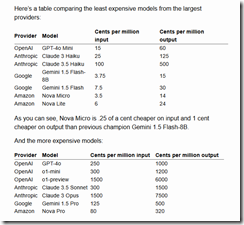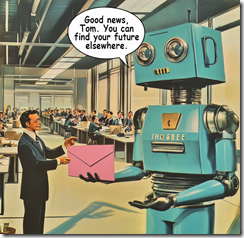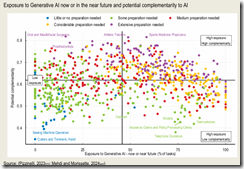ChatGPT: The New Chegg
December 13, 2024
Chegg is an education outfit. The firm has faced some magnetic interference related to its academic compass. An outfit in Australia has suggested that Chegg makes it possible for a student to obtain some assistance in order to complete certain work. Beyond Search knew AI would displace some workers and maybe even shutter some companies. But it is hard to find sympathy for this particular victim. “Chegg Is on Its Last Legs After ChatGPT Sent Its Stock Down 99%,” reports Gizmodo. So industrial scale cheating kills rich-kid cheating. Oh no.
Those of us who got our college degrees last century may not be familiar with Chegg. Writer Thomas Maxwell explains:
“[Chegg] started out in the 2000s renting out textbooks and later expanded into online study guides, and eventually into a platform with pre-written answers to common homework questions. Unfortunately, the launch of ChatGPT all but annihilated Chegg’s business model. The company for years paid thousands of contractors to write answers to questions across every major subject, which is quite a labor intensive process—and there’s no guarantee they will even have the answer to your question. ChatGPT, on the other hand, has ingested pretty much the entire internet and has likely seen any history question you might throw at it.”
Yep. The Wall Street Journal reports Chegg put off developing its own AI tools because of machine learning’s propensity for wrong answers. And rightly so. Maxwell suggests the firm might be able to make that case to “curious” students, but we agree that would be a long shot at this point. If Chegg does indeed go under, we will not mourn. But what other businesses, and the workers they support, will be next to fall?
Does the US smart software sector care if their products help students appear smarter and more diligent than they are in real life? Nope. Success in the US is, like much of the high-technology hoo-hah, creating a story and selling illusion. School education is collateral damage.
Cynthia Murrell, December 13, 2024
Autonomous AI Agents: The Next Big Thing for a Rolodex-Type Service
December 13, 2024
Are the days of large language models numbered? Yes, according to the CEO and co-founder of Salesforce. Finance site Benzinga shares, “Marc Benioff Says Future of AI Not in Bots Like ChatGPT But In Autonomous Agents.” Writer Ananya Gairola points to a recent Wall Street Journal podcast in which Benioff shared his thoughts:
“He stated that the next phase of AI development will focus on autonomous agents, which can perform tasks independently, rather than relying on LLMs to drive advancements. He argued that while AI tools like ChatGPT have received significant attention, the real potential lies in agents. ‘Has the AI taken over? No. Has AI cured cancer? No. Is AI curing climate change? No. So we have to keep things in perspective here,’ he stated. Salesforce provides both prebuilt and customizable AI agents for businesses looking to automate customer service functions. ‘But we are not at that moment that we’ve seen in these crazy movies — and maybe we will be one day, but that is not where we are today,’ Benioff stated during the podcast.”
Someday, he says. But it would seem the race is on. Gairola notes OpenAI is poised to launch its own autonomous AI agent in January. Will that company dominate the autonomous AI field, as it has with generative AI? Will the new bots come equipped with bias and hallucinations? Stay tuned.
Cynthia Murrell, December 13, 2024
Do Not Worry About Tomorrow. Worry About Tod”AI”
December 12, 2024
 This blog post flowed from the sluggish and infertile mind of a real live dinobaby. If there is art, smart software of some type was probably involved.
This blog post flowed from the sluggish and infertile mind of a real live dinobaby. If there is art, smart software of some type was probably involved.
According to deep learning pioneer Yoshua Bengio, we may be headed for utopia—at least if one is a certain wealthy tech-bro type. For the rest of us, not so much. The Byte tells us, “Godfather of AI Warns of Powerful People who Want Humans ‘Replaced by Machines’.” He is not referring to transhumanism, which might ultimately seek to transform humans into machines. No, this position is about taking people out of the equation entirely. Except those at the top, presumably. Reporter Noor Al-Sibai writes:
“In an interview with CNBC, computer science luminary Yoshua Bengio said that members of an elite tech ‘fringe’ want AI to replace humans. The head of the University of Montreal’s Institute for Learning Algorithms, Bengio was among the public signatories of the ‘Right to Warn‘ open letter penned by leading AI researchers at OpenAI who claim they’re being silenced about the technology’s dangers. Along with famed experts Yann LeCun and Geoffrey Hinton, he’s sometimes referred to as one of the ‘Godfathers of AI.’ ‘Intelligence gives power. So who’s going to control that power?’ the preeminent machine learning expert told the outlet during the One Young World Summit in Montreal. ‘There are people who might want to abuse that power, and there are people who might be happy to see humanity replaced by machines,’ Bengio claimed. ‘I mean, it’s a fringe, but these people can have a lot of power, and they can do it unless we put the right guardrails right now.’”
Indeed. This is not the first time the esteemed computer scientist has rung AI alarm bells. As Bengio notes, those who can afford to build AI systems are very, very rich. And money leads to other types of power. Political and military power. Can government regulations catch up to these players? Only if it takes them more than five years to attain artificial general intelligence, he predicts. The race for the future of humanity is being evaluated by what’s cheaper, not better.
Cynthia Murrell, December 12, 2024
Bitext NAMER: Simplifying Tracking of Translated Organizational Names
December 11, 2024
 This blog post is the work of an authentic dinobaby. No smart software was used.
This blog post is the work of an authentic dinobaby. No smart software was used.
We wrote a short item about tracking Chinese names translated to English, French, or Spanish with widely varying spellings. Now Bitext’s entity extraction system can perform the same disambiguation for companies and non-governmental entities. Analysts may be looking for a casino which operates with a Chinese name. That gambling facility creates marketing collateral or gets news coverage which uses a different name or a spelling which is different from the operation’s actual name. As a result, missing a news item related to that operation is an on-going problem for some professionals.
Bitext has revealed that its proprietary technology can perform the same tagging and extraction process for organizational names in more than two dozen languages. In “Bitext NAMER Cracks Named Entity Recognition,” the company reports:
… issues arise with organizational names, such as “Sun City” (a place and enterprise) or aliases like “Yati New City” for “Shwe Koko”; and, in general, with any language that is written in non-Roman alphabet and needs transliteration. In fact, these issues affect to all languages that do not use Roman alphabet including Hindi, Malayalam or Vietnamese, since transliteration is not a one-to-one function but a one-to-many and, as a result, it generates ambiguity the hinders the work of analysts. With real-time data streaming into government software, resolving ambiguities in entity identification is crucial, particularly for investigations into activities like money laundering.
Unlike some other approaches — for instance, smart large language models — the Bitext NAMER technology:
- Identifies correctly generic names
- Performs type assignment; specifically, person, place, time, and organization
- Tags AKA (also known as) and pseudonyms
- Distinguishes simile names linked to unelated entitles; for example, Levo Chan.
The company says:
Our unique method enables accurate, multilingual entity detection and normalization for a variety of applications.
Bitext’s technology is used by three of the top five US companies listed on NASDAQ. The firm’s headquarters are in Madrid, Spain. For more information, contact the company via its Web site, www.bitext.com.
Stephen E Arnold, December 11, 2024
KPMG FOMO on AI
December 11, 2024
 This blog post flowed from the sluggish and infertile mind of a real live dinobaby. If there is art, smart software of some type was probably involved.
This blog post flowed from the sluggish and infertile mind of a real live dinobaby. If there is art, smart software of some type was probably involved.
AI is in demand and KPMG long ago received the message that it needs to update its services to include AI consulting services in its offerings. Technology Magazine shares the story in: “Growing KPMG-Google Cloud Ties Signal AI Services Shift.” Google Cloud and KPMG have a partnership that started when the latter’s clients wanted to implement Google Cloud into their systems. KPMG’s client base increased tenfold when they deployed Google Cloud services.
The nature of the partnership will change to Google’s AI-related services and KPMG budgeted $100 million to the project. The investment is projected to give KPMG $1 billion in revenue for its generative AI technology. KPMG deployed Google’s enterprise search technology Vertex AI Search into its cloud services. Vertex AI and retrieval augmented generation (RAG), a process that checks AI responses with verified data, are being designed to analyze and assist with market and research analysis.
The partnership between these tech companies indicates this is where the tech industry is going:
“The partnership indicates how professional services firms are evolving their technology practices. KPMG’s approach combines its industry expertise with Google Cloud’s technical infrastructure, creating services that bridge the gap between advanced technology and practical business applications… The collaboration also reflects how enterprise AI adoption is maturing. Rather than implementing generic AI solutions, firms are now seeking industry-specific applications that integrate with existing systems and workflows. This approach requires deep understanding of both technical capabilities and sector-specific challenges.”
Need an accounting firm? Well, AI is accounting. Need a consultant. Well, AI is consulting. Need motivated people to bill your firm by the hour at exorbitant fees? You know whom to call.
Whitney Grace, December 11, 2024
AI Automation: Spreading Like Covid and Masks Will Not Help
December 10, 2024
 This blog post flowed from the sluggish and infertile mind of a real live dinobaby. If there is art, smart software of some type was probably involved.
This blog post flowed from the sluggish and infertile mind of a real live dinobaby. If there is art, smart software of some type was probably involved.
Reddit is the one of the last places on the Internet where you can find quality and useful information. Reddit serves as the Internet’s hub for news, tech support, trolls, and real-life perspectives about jobs. Here’s a Reddit downer in the ChatGPT thread for anyone who works in a field that can be automated: “Well this is it boys. I was just informed from my boss and HR that my entire profession is being automated away.”
For brevity’s sake here is the post:
“For context I work production in local news. Recently there’s been developments in AI driven systems that can do 100% of the production side of things which is, direct, audio operate, and graphic operate -all of those jobs are all now gone in one swoop. This has apparently been developed by the company Q ai. For the last decade I’ve worked in local news and have garnered skills I thought I would be able to take with me until my retirement, now at almost 30 years old, all of those job opportunities for me are gone in an instant. The only person that’s keeping their job is my manager, who will overlook the system and do maintenance if needed. That’s 20 jobs lost and 0 gained for our station. We were informed we are going to be the first station to implement this under our company. This means that as of now our entire production staff in our news station is being let go. Once the system is implemented and running smoothly then this system is going to be implemented nationwide (effectively eliminating tens of thousands of jobs.) There are going to be 0 new jobs built off of this AI platform. There are people I work with in their 50’s, single, no college education, no family, and no other place to land a job once this kicks in. I have no idea what’s going to happen to them. This is it guys. This is what our future with AI looks like. This isn’t creating any new jobs this is knocking out entire industry level jobs without replacing them.”
The post is followed by comments of commiseration, encouragement, and the usual doom and gloom. It’s not surprising that local news stations are automating their tasks, especially with the overhead associates with employees. These include: healthcare, retirement package, vacation days, PTO, and more. AI is the perfect employee, because it doesn’t complain or take time off. AI, however, is lacking basic common sense and fact checking. We’re witnessing a change in how the job market, it just sucks to live through it.
Whitney Grace, December 10, 2024
Amazon: Black FridAI for Smart Software Arrives
December 9, 2024
 This write up was created by an actual 80-year-old dinobaby. If there is art, assume that smart software was involved. Just a tip.
This write up was created by an actual 80-year-old dinobaby. If there is art, assume that smart software was involved. Just a tip.
Five years ago, give or take a year, my team and I were giving talks about Amazon. Our topics touched on Amazon’s blockchain patents, particularly some interesting cross blockchain filings, and Amazon’s idea for “off the shelf” smart software. At the time, we compared the blockchain patents to examining where data resided across different public ledgers. We also showed pictures of Lego blocks. The idea was that a customer of Amazon Web Service could select a data package, a model, and some other Amazon technologies and create amazing AWS-infused online confections.
Thanks, MidJourney. Good enough.
Well, as it turned out the ideas were interesting, but Amazon just did not have the crate engine stuffed in its digital flea market to make the ideas go fast. The fix has been Amazon’s injections of cash and leadership attention into Anthropic and a sweeping concept of partnering with other AI outfits. (Hopefully one of these ideas will make Amazon’s Alexa into more than a kitchen timer. Well, we’ll see.)
I read “First Impressions of the New Amazon Nova LLMs (Via a New LLM-Bedrock Plugin).” I am going to skip the Amazon jargon and focus on one key point in the rah rah write up:
This is a nicely presented pricing table. You can work through the numbers and figure out how much Amazon will “save” some AI-crazed customer. I want to point out that Amazon is bringing price cutting to the world of smart software. Every day will be a Black FridAI for smart software.
That’s right. Amazon is cutting prices for AI, and that is going to set the stage for a type of competitive joust most of the existing AI players were not expecting to confront. Sure, there are “free” open source models, but you have to run them somewhere. Amazon wants to be that “where”.
If Amazon pulls off this price cutting tactic, some customers will give the system a test drive. Amazon offers a wide range of ways to put one’s toes in the smart software swimming pool. There are training classes; there will be presentations at assorted Amazon events; and there will be a slick way to make Amazon’s smart software marketing make money. Not too many outfits can boost advertising prices and Prime membership fees as part of the smart software campaign.
If one looks at Amazon’s game plan over the last quarter century, the consequences are easy to spot: No real competition for digital books or for semi affluent demographics desire to have Amazon trucks arrive multiple times a day. There is essentially no quality or honesty controls on some of the “partners” in the Amazon ecosystem. And, I personally received a pair of large red women’s underpants instead of an AMD Ryzen CPU. I never got the CPU, but Amazon did not allow me to return the unused thong. Charming.
Now it is possible that this cluster of retail tactics will be coming to smart software. Am I correct, or am I just reading into the play book which has made Amazon a fave among so many vendors of so many darned products?
Worth watching because price matters.
Stephen E Arnold, December 9, 2024
Smart Software Is Coming for You. Yes, You!
December 9, 2024
 This write up was created by an actual 80-year-old dinobaby. If there is art, assume that smart software was involved. Just a tip.
This write up was created by an actual 80-year-old dinobaby. If there is art, assume that smart software was involved. Just a tip.
“Those smart software companies are not going to be able to create a bot to do what I do.” — A CPA who is awash with clients and money.
Now that is a practical, me–me-me idea. However, the estimable Organization for Economic Co-Operation and Development (OECD, a delightful acronym) has data suggesting a slightly different point of view: Robots will replace workers who believe themselves unreplaceable. (The same idea is often held by head coaches of sports teams losing games.)
Thanks, MidJourney. Good enough.
The report is titled in best organizational group think: Job Creation and Local Economic Development 2024; The Geography of Generative AI.
I noted this statement in the beefy document, presumably written by real, live humanoids and not a ChatGPT type system:
In fact, the finance and insurance industry is the tightest industry in the United States, with 2.5 times more vacancies per filled position than the regional average (1.6 times in the European Union).
I think this means that financial institutions will be eager to implement smart software to become “workers.” If that works, the confident CPA quoted at the beginning of this blog post is going to get a pink slip.
The OECD report believes that AI will have a broad impact. The most interesting assertion / finding in the report is that one-fifth of the tasks a worker handles can be handled by smart software. This figure is interesting because smart software hallucinates and is carrying the hopes and dreams of many venture outfits and forward leaning wizards on its digital shoulders.
And what’s a bureaucratic report without an almost incomprehensible chart like this one from page 145 of the report?
Look closely and you will see that sewing machine operators are more likely to retain jobs than insurance clerks.
Like many government reports, the document focuses on the benefits of smart software. These include (cue the theme from Star Wars, please) more efficient operations, employees who do more work and theoretically less looking for side gigs, and creating ways for an organization to get work done without old-school humans.
Several observations:
- Let’s assume smart software is almost good enough, errors and all. The report makes it clear that it will be grabbed and used for a plethora of reasons. The main one is money. This is an economic development framework for the research.
- The future is difficult to predict. After scanning the document, I was thinking that a couple of college interns and an account to You.com would be able to generate a reasonable facsimile of this report.
- Agents can gather survey data. One hopes this use case takes hold in some quasi government entities. I won’t trot out my frequently stated concerns about “survey” centric reports.
Stephen E Arnold, December 9, 2024
Grousing about Smart Software: Yeah, That Will Work
December 6, 2024
 This is the work of a dinobaby. Smart software helps me with art, but the actual writing? Just me and my keyboard.
This is the work of a dinobaby. Smart software helps me with art, but the actual writing? Just me and my keyboard.
I read “Writers Condemn Startup’s Plans to Publish 8,000 Books Next Year Using AI.” The innovator is an outfit called Spines. Cute, book spines and not mixed up with spiny mice or spiny rats.
The write up reports:
Spines – which secured $16m in a recent funding round – says that authors will retain 100% of their royalties. Co-founder Yehuda Niv, who previously ran a publisher and publishing services business in Israel, claimed that the company “isn’t self-publishing” or a vanity publisher but a “publishing platform”.
A platform, not a publisher. The difference is important because venture types don’t pump cash into traditional publishing companies in my experience.
The article identified another key differentiator for Spines:
Spines says it will reduce the time it takes to publish a book to two to three weeks.
When publishers with whom I worked talked about time, the units were months. In one case, it was more than a year. When I was writing books, the subject matter changed on a slightly different time scale. Traditional publishers do not zip along with the snappiness of a two year old French bulldog.
Spines is quoted in the write up as saying:
[We are] levelling the playing field for any person who aspires to be an author to get published within less than three weeks and at a fraction of the cost. Our goal is to help one million authors to publish their books using technology….”
Yep, technology. Is that a core competency of big time publishers?
Several observations from my dinobaby-friendly lair:
- If Spines works — that is, makes lots of money — a traditional publisher will probably buy the company and sue any entity which impinges on its “original” ideas.
- Costs for instant publishing on Amazon remain more attractive. The fees are based on delivery of digital content and royalties assessed. Spines may have to spend money to find writers able to pay the company to do the cover, set up, design, etc.
- Connecting agentic AI into a Spines-type service may be interesting to some.
Stephen E Arnold, December 6, 2024
Batting Google and Whiffing the Chance
December 6, 2024
 This is the work of a dinobaby. Smart software helps me with art, but the actual writing? Just me and my keyboard.
This is the work of a dinobaby. Smart software helps me with art, but the actual writing? Just me and my keyboard.
I read “The AI War Was Never Just about AI.” Okay, AI war. We have a handful of mostly unregulated technology companies, a few nation states, and some unknown wizards working in their family garage. The situation is that a very tiny number of companies are fighting to become de facto reality definers for the next few years, maybe a decade or two. Against that background, does a single country’s judiciary think it can “regulate” an online company. One pragmatic approach has been to ban a service, the approach taken by Australia, China, Iran, and Russia among others. A less popular approach would be to force the organization out of business by arresting key executives, seizing assets, and imposing penalties on that organization’s partners. Does that sound a bit over the top?
The cited article does not go to the pit in the apricot. Google has been allowed to create an interlocking group of services which permeate the fabric of global online activity. There is no entertainment for some people in Armenia except YouTube. There are few choices to promote a product online without bumping into the Disney style people herders who push those who want to sell toward Google’s advertising systems. There is no getting from Point A to Point B without Google’s finding services whether dolled up in an AI wrapper, a digital version of a map, or a helpful message on the sign of a lawn service truck for Google Local.
The write up says:
The government wants to break up Google’s monopoly over the search market, but its proposed remedies may in fact do more to shape the future of AI. Google owns 15 products that serve at least half a billion people and businesses each—a sprawling ecosystem of gadgets, search and advertising, personal applications, and enterprise software. An AI assistant that shows up in (or works well with) those products will be the one that those people are most likely to use. And Google has already woven its flagship Gemini AI models into Search, Gmail, Maps, Android, Chrome, the Play Store, and YouTube, all of which have at least 2 billion users each. AI doesn’t have to be life-changing to be successful; it just has to be frictionless.
Okay. With a new administration taking the stage, how will this goal of leveling the playing field work. The legal processes at Google’s disposal mean that whatever the US government does can be appealed. Appeals take time. Who lasts longer? A government lawyer working under the thumb of DOGE and budget cutting or a giant outfit like Google? My view is that Google has more lawyers and more continuity.
Second, breaking up Google may face some headwinds from government entities quite dependent on its activities. The entire OSINT sector looks to Google for nuggets of information. It is possible some government agencies have embedded Google personnel on site. The “advertising” industry depends on distribution via the online stores of Apple and Google. Why is this important? The data brokers repackage the app data into data streams consumed by some government agencies and their contractors.
The write up says:
This is why it’s relevant that the DOJ’s proposed antitrust remedy takes aim at Google’s broader ecosystem. Federal and state attorneys asked the court to force Google to sell off its Chrome browser; cease preferencing its search products in the Android mobile operating system; prevent it from paying other companies, including Apple and Samsung, to make Google the default search engine; and allow rivals to syndicate Google’s search results and use its search index to build their own products. All of these and the DOJ’s other requests, under the auspices of search, are really shots at Google’s expansive empire.
So after more than 20 years of non regulation and hand slapping, the current legal decision is going to take apart an entity which is more like a cancer than a telephone company like AT&T. IBM was mostly untouched by the US government as was Microsoft. Now I am to to believe that a vastly different type of commercial enterprise which is for some functions more robust and effective than a government can have its wings clipped.
Is the Department of Justice concerned about AI? Come on. The DoJ personnel are thinking about the Department of Government Efficiency, presidential retribution, and enhancing LinkedIn profiles.
We are not in Kansas any longer where there is no AI war.
Stephen E Arnold, December 6, 2024






